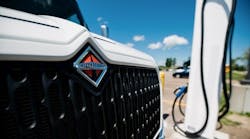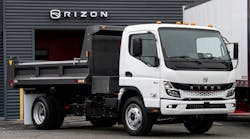Chesapeake Energy began to convert its entire fleet of almost 6,000 vehicles (80% trucks and 20% sedans and SUVs) to run on compressed natural gas (CNG) in late 2007. According to Nate Pumphrey, director of fleet operations for the company, the conversion project has been going quickly and well. What is more, the payback has been there, too. Fleet Owner had the opportunity to talk with Pumphrey about the move to natural gas and what Chesapeake is doing to make the program a success in terms of sustainability and the bottom line.
“This all started way back in 2007,” Pumphrey told Fleet Owner. “Our CEO initiated it. He said, ‘I’m hearing more about natural gas [as a vehicle fuel]. I think it is time we started looking at this.’”
According to Pumphrey, they had to do a lot of research in the early years. “We talked to a lot of experts,” he said, “and it became pretty apparent that this was a good idea. We decided we wanted to convert all our vehicles to CNG and, where desirable, to run stationary power units on natural gas, too. Since we are in the natural gas business, I suppose it was a little like a dairy farmer drinking the milk from his own farm. We also cared a lot about using a ‘green’ fuel and about helping the country to become more energy independent.
“Once we began, it really happened pretty quickly. We hold ourselves to an 80% CNG utilization rate,” he continued. “We have some bi-fuel vehicles which use CNG and gasoline and some vehicles that are one hundred percent CNG. We’ve targeted 2014 as the completion date for the whole fleet, and I am very confident we will be there.”
Chesapeake has also held itself to a strict schedule as far as managing the CNG fleet goes, from purchase of new equipment through trade-in. “You have to remarket CNG vehicles where there is a demand and where there is [infrastructure and maintenance] support,” Pumphrey noted. “We trade our vehicles at 90,000 miles, while they are still under power train warranty.
“Recently, we’ve actually begun seeing residual values,” he said. “There is an extremely strong demand for CNG vehicles at auction. Natural gas vehicles can command $5,000 to $6,000 more than their gasoline-powered counterparts.
“We are cycling them back pretty early, we know,” he added. “There is a temptation to keep them longer for the fuel cost-saving benefit, but it is a balancing act when you factor in maintenance. The CNG vehicles require an additional filter change. And every three years, the fuel tanks have to be inspected and recertified. On the other hand, the cleaner fuel is reducing some maintenance costs. Most of our vehicles run about 30,000 miles per year.
“If other fleets would like to see our numbers, we are an open book,” he said. “We are excited to share information about this.”
Pumphrey also noted that the company has to insure that drivers go to CNG-certified maintenance facilities with trained mechanics. “The good news is that Ford, Chrysler and General Motors have all embraced this need for maintenance support for 2013,” he said. “I could see more fleets outsourcing the maintenance of their CNG vehicles. Shop ventilation is a big deal with natural gas.”
The new CNG-powered vehicles have generally been well-received by drivers, according to Pumphrey, who noted that they had seen only “negligible” power and performance issues. “The biggest thing for drivers is just a change in the fuel fill schedule,” he said. “They have to refuel more times per week, but the cost savings is worth it. You get a big reinforcement for what you are doing every time you see the cost at the pump.”
Speaking of costs, Pumphrey said that the incremental cost for a CNG-powered light-duty truck versus a gasoline-powered truck has been about $9,000, but that spread has been dropping as economies of scale come into play. Today, Chesapeake is seeing an ROI in as few as 19 months in states where there are incentives for buying natural gas vehicles. The payback is 36 to 39 months in states where there are no incentives and ROI is based on the price differential between CNG and gasoline.
Chesapeake has not only been buying and operating natural gas vehicles, the company is also investing heavily in helping to build out the natural gas fueling infrastructure. “We’ve done a lot to help bolster the natural gas fueling infrastructure,” Pumphrey said. “Chesapeake partners with national retailers. It is easy for us to guarantee the fuel volumes [we will purchase.] Partnering works; it shares the burden and it shares the advantages.”
Last July, the company announced that it would invest $150 million in Clean Energy Fuels Corporation to help underwrite approximately 150 liquid natural gas (LNG) fueling stations for heavy-duty trucks along major interstate routes. Chesapeake is making the investment in Clean Energy through its newly formed, wholly owned subsidiary, Chesapeake NG Ventures Corporation (CNGV). Many of the LNG fueling stations will be co-located at Pilot-Flying J Travel Centers.
Pumphrey is bullish on natural gas for powering America’s fleets. “This is just an exciting thing to be a part of,” he said. “There are three good reasons that each stand on their own to go with natural gas---fuel price, energy independence and the opportunity to run a cleaner, greener operation.”


